Nursing Handover: Importance and Role in Patient Care (Essay)
VerifiedAdded on 2022/11/13
|7
|1574
|470
Essay
AI Summary
This essay delves into the critical significance of nursing handover in healthcare settings. It highlights how effective communication during handover processes, such as shift changes, directly impacts patient safety and the quality of care. The essay emphasizes the promotion of person-centered care, where patients are actively involved in their treatment plans, and how nursing handovers facilitate this approach. Moreover, it explores the cultivation of a supportive teamwork culture within healthcare environments, emphasizing how clear communication during handovers can reduce errors and enhance staff solidarity. The essay also addresses the role of nursing handover in mitigating occupational stress and fatigue among nurses, ultimately contributing to improved patient outcomes and a more efficient healthcare system. The essay concludes by underscoring the necessity of robust handover practices for maintaining continuity of care and ensuring positive patient experiences, supported by relevant research and references.
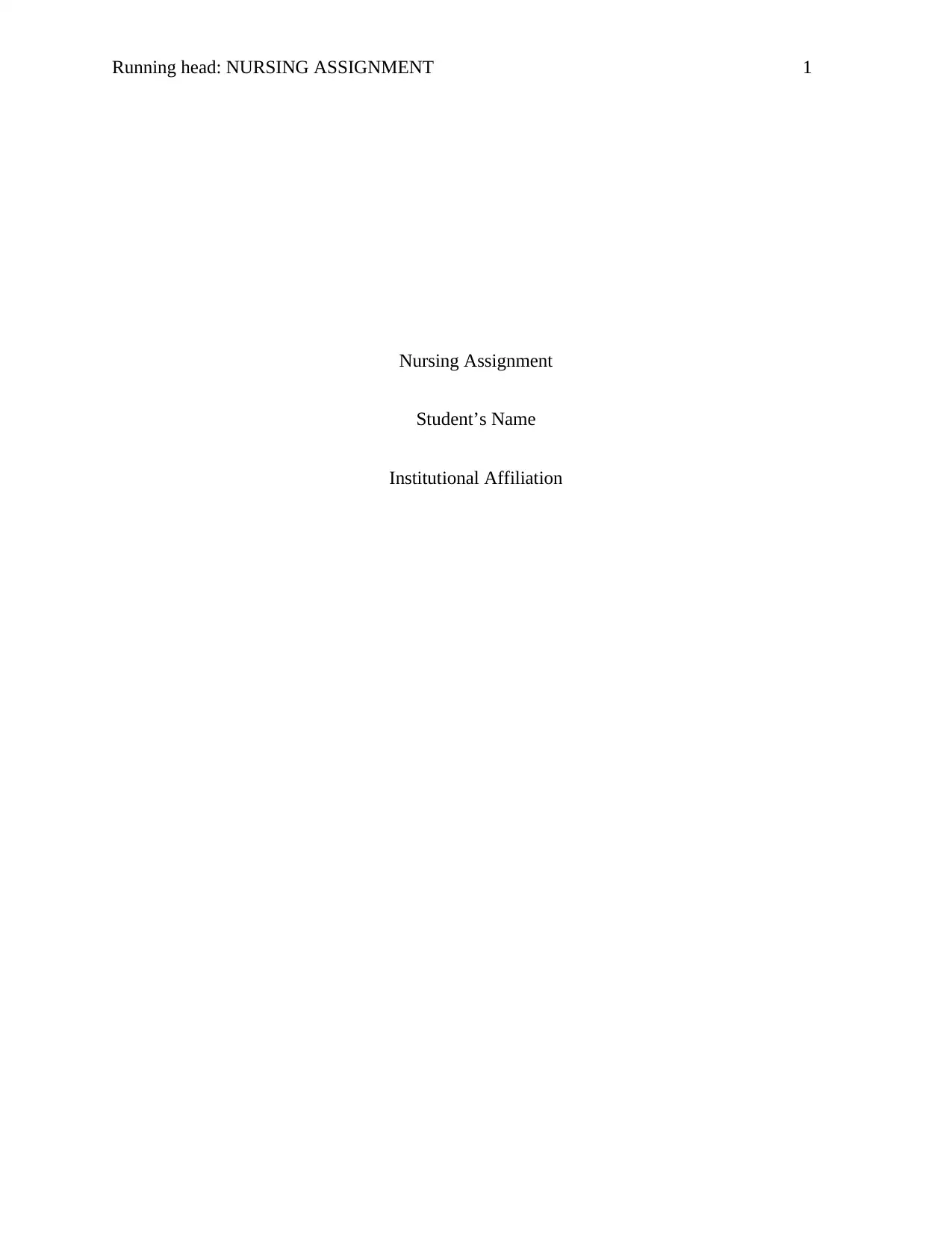
Running head: NURSING ASSIGNMENT 1
Nursing Assignment
Student’s Name
Institutional Affiliation
Nursing Assignment
Student’s Name
Institutional Affiliation
Paraphrase This Document
Need a fresh take? Get an instant paraphrase of this document with our AI Paraphraser
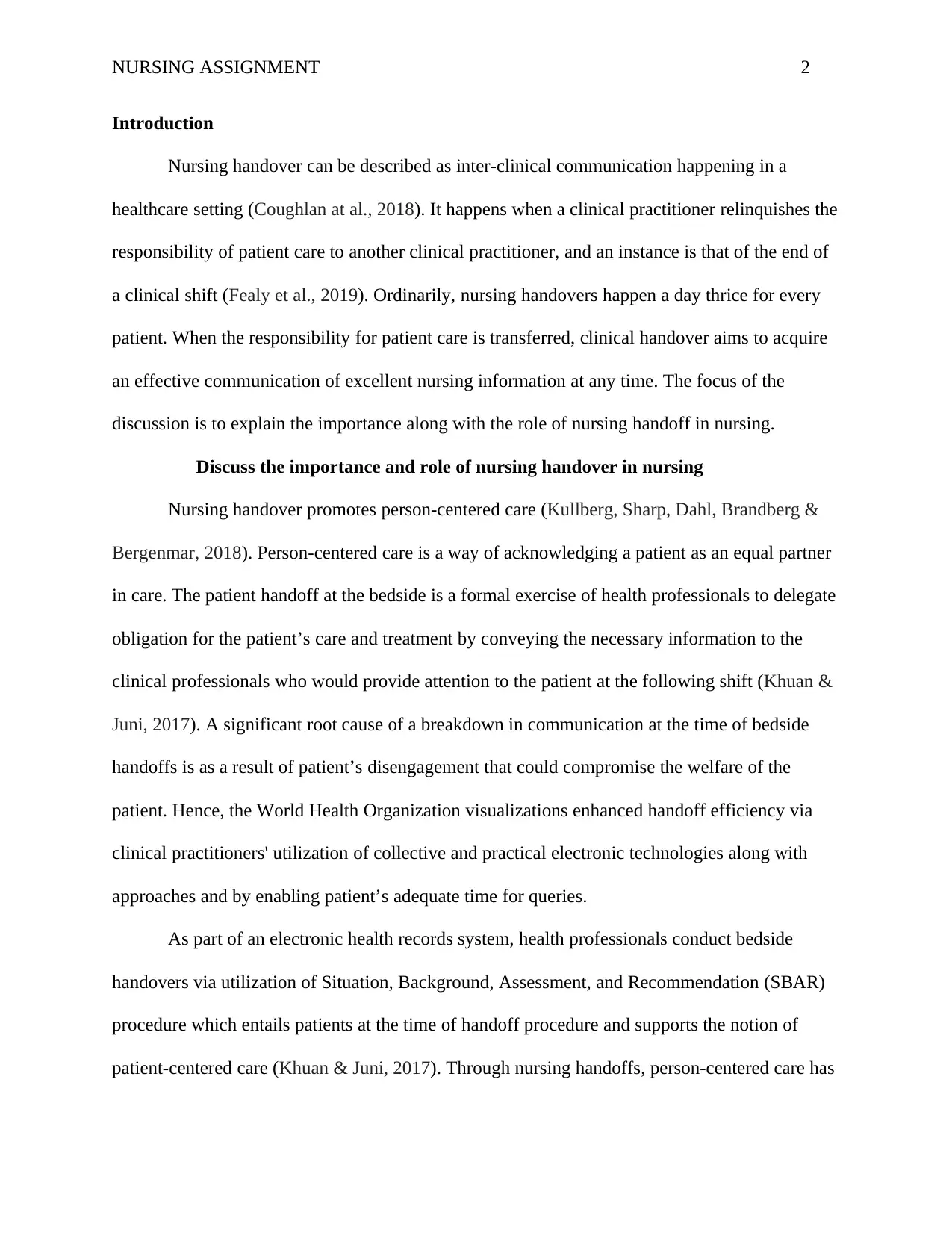
NURSING ASSIGNMENT 2
Introduction
Nursing handover can be described as inter-clinical communication happening in a
healthcare setting (Coughlan at al., 2018). It happens when a clinical practitioner relinquishes the
responsibility of patient care to another clinical practitioner, and an instance is that of the end of
a clinical shift (Fealy et al., 2019). Ordinarily, nursing handovers happen a day thrice for every
patient. When the responsibility for patient care is transferred, clinical handover aims to acquire
an effective communication of excellent nursing information at any time. The focus of the
discussion is to explain the importance along with the role of nursing handoff in nursing.
Discuss the importance and role of nursing handover in nursing
Nursing handover promotes person-centered care (Kullberg, Sharp, Dahl, Brandberg &
Bergenmar, 2018). Person-centered care is a way of acknowledging a patient as an equal partner
in care. The patient handoff at the bedside is a formal exercise of health professionals to delegate
obligation for the patient’s care and treatment by conveying the necessary information to the
clinical professionals who would provide attention to the patient at the following shift (Khuan &
Juni, 2017). A significant root cause of a breakdown in communication at the time of bedside
handoffs is as a result of patient’s disengagement that could compromise the welfare of the
patient. Hence, the World Health Organization visualizations enhanced handoff efficiency via
clinical practitioners' utilization of collective and practical electronic technologies along with
approaches and by enabling patient’s adequate time for queries.
As part of an electronic health records system, health professionals conduct bedside
handovers via utilization of Situation, Background, Assessment, and Recommendation (SBAR)
procedure which entails patients at the time of handoff procedure and supports the notion of
patient-centered care (Khuan & Juni, 2017). Through nursing handoffs, person-centered care has
Introduction
Nursing handover can be described as inter-clinical communication happening in a
healthcare setting (Coughlan at al., 2018). It happens when a clinical practitioner relinquishes the
responsibility of patient care to another clinical practitioner, and an instance is that of the end of
a clinical shift (Fealy et al., 2019). Ordinarily, nursing handovers happen a day thrice for every
patient. When the responsibility for patient care is transferred, clinical handover aims to acquire
an effective communication of excellent nursing information at any time. The focus of the
discussion is to explain the importance along with the role of nursing handoff in nursing.
Discuss the importance and role of nursing handover in nursing
Nursing handover promotes person-centered care (Kullberg, Sharp, Dahl, Brandberg &
Bergenmar, 2018). Person-centered care is a way of acknowledging a patient as an equal partner
in care. The patient handoff at the bedside is a formal exercise of health professionals to delegate
obligation for the patient’s care and treatment by conveying the necessary information to the
clinical professionals who would provide attention to the patient at the following shift (Khuan &
Juni, 2017). A significant root cause of a breakdown in communication at the time of bedside
handoffs is as a result of patient’s disengagement that could compromise the welfare of the
patient. Hence, the World Health Organization visualizations enhanced handoff efficiency via
clinical practitioners' utilization of collective and practical electronic technologies along with
approaches and by enabling patient’s adequate time for queries.
As part of an electronic health records system, health professionals conduct bedside
handovers via utilization of Situation, Background, Assessment, and Recommendation (SBAR)
procedure which entails patients at the time of handoff procedure and supports the notion of
patient-centered care (Khuan & Juni, 2017). Through nursing handoffs, person-centered care has
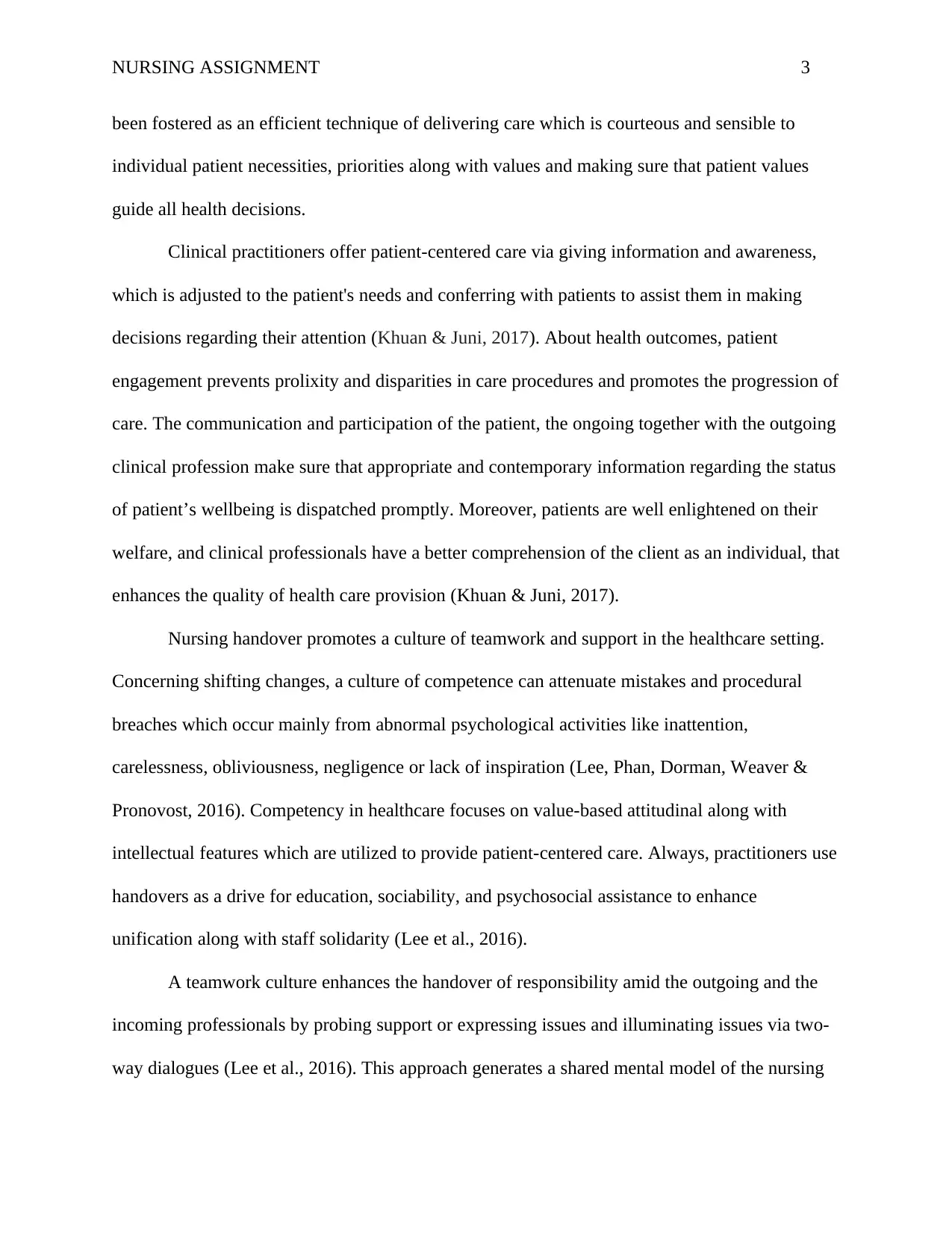
NURSING ASSIGNMENT 3
been fostered as an efficient technique of delivering care which is courteous and sensible to
individual patient necessities, priorities along with values and making sure that patient values
guide all health decisions.
Clinical practitioners offer patient-centered care via giving information and awareness,
which is adjusted to the patient's needs and conferring with patients to assist them in making
decisions regarding their attention (Khuan & Juni, 2017). About health outcomes, patient
engagement prevents prolixity and disparities in care procedures and promotes the progression of
care. The communication and participation of the patient, the ongoing together with the outgoing
clinical profession make sure that appropriate and contemporary information regarding the status
of patient’s wellbeing is dispatched promptly. Moreover, patients are well enlightened on their
welfare, and clinical professionals have a better comprehension of the client as an individual, that
enhances the quality of health care provision (Khuan & Juni, 2017).
Nursing handover promotes a culture of teamwork and support in the healthcare setting.
Concerning shifting changes, a culture of competence can attenuate mistakes and procedural
breaches which occur mainly from abnormal psychological activities like inattention,
carelessness, obliviousness, negligence or lack of inspiration (Lee, Phan, Dorman, Weaver &
Pronovost, 2016). Competency in healthcare focuses on value-based attitudinal along with
intellectual features which are utilized to provide patient-centered care. Always, practitioners use
handovers as a drive for education, sociability, and psychosocial assistance to enhance
unification along with staff solidarity (Lee et al., 2016).
A teamwork culture enhances the handover of responsibility amid the outgoing and the
incoming professionals by probing support or expressing issues and illuminating issues via two-
way dialogues (Lee et al., 2016). This approach generates a shared mental model of the nursing
been fostered as an efficient technique of delivering care which is courteous and sensible to
individual patient necessities, priorities along with values and making sure that patient values
guide all health decisions.
Clinical practitioners offer patient-centered care via giving information and awareness,
which is adjusted to the patient's needs and conferring with patients to assist them in making
decisions regarding their attention (Khuan & Juni, 2017). About health outcomes, patient
engagement prevents prolixity and disparities in care procedures and promotes the progression of
care. The communication and participation of the patient, the ongoing together with the outgoing
clinical profession make sure that appropriate and contemporary information regarding the status
of patient’s wellbeing is dispatched promptly. Moreover, patients are well enlightened on their
welfare, and clinical professionals have a better comprehension of the client as an individual, that
enhances the quality of health care provision (Khuan & Juni, 2017).
Nursing handover promotes a culture of teamwork and support in the healthcare setting.
Concerning shifting changes, a culture of competence can attenuate mistakes and procedural
breaches which occur mainly from abnormal psychological activities like inattention,
carelessness, obliviousness, negligence or lack of inspiration (Lee, Phan, Dorman, Weaver &
Pronovost, 2016). Competency in healthcare focuses on value-based attitudinal along with
intellectual features which are utilized to provide patient-centered care. Always, practitioners use
handovers as a drive for education, sociability, and psychosocial assistance to enhance
unification along with staff solidarity (Lee et al., 2016).
A teamwork culture enhances the handover of responsibility amid the outgoing and the
incoming professionals by probing support or expressing issues and illuminating issues via two-
way dialogues (Lee et al., 2016). This approach generates a shared mental model of the nursing
⊘ This is a preview!⊘
Do you want full access?
Subscribe today to unlock all pages.

Trusted by 1+ million students worldwide
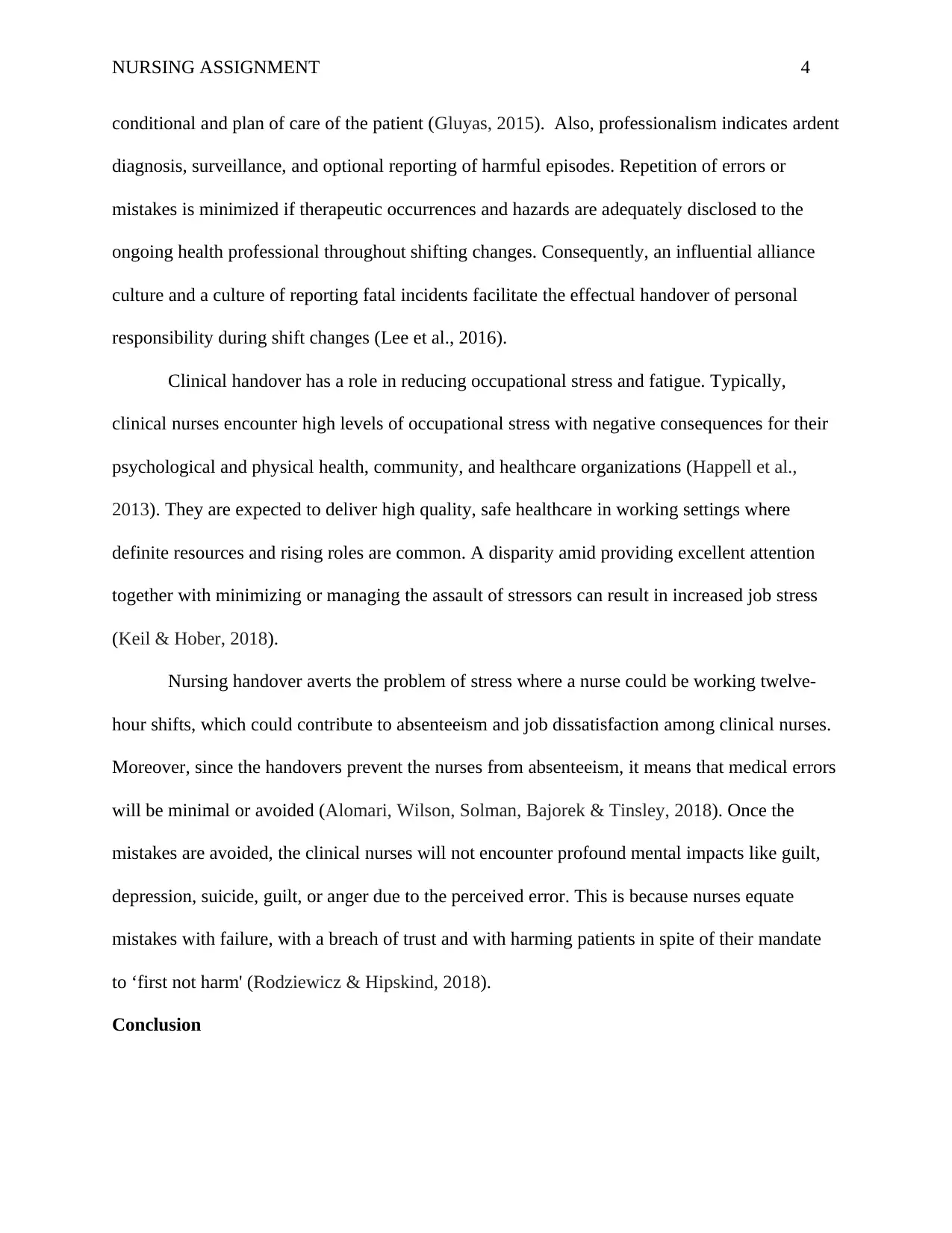
NURSING ASSIGNMENT 4
conditional and plan of care of the patient (Gluyas, 2015). Also, professionalism indicates ardent
diagnosis, surveillance, and optional reporting of harmful episodes. Repetition of errors or
mistakes is minimized if therapeutic occurrences and hazards are adequately disclosed to the
ongoing health professional throughout shifting changes. Consequently, an influential alliance
culture and a culture of reporting fatal incidents facilitate the effectual handover of personal
responsibility during shift changes (Lee et al., 2016).
Clinical handover has a role in reducing occupational stress and fatigue. Typically,
clinical nurses encounter high levels of occupational stress with negative consequences for their
psychological and physical health, community, and healthcare organizations (Happell et al.,
2013). They are expected to deliver high quality, safe healthcare in working settings where
definite resources and rising roles are common. A disparity amid providing excellent attention
together with minimizing or managing the assault of stressors can result in increased job stress
(Keil & Hober, 2018).
Nursing handover averts the problem of stress where a nurse could be working twelve-
hour shifts, which could contribute to absenteeism and job dissatisfaction among clinical nurses.
Moreover, since the handovers prevent the nurses from absenteeism, it means that medical errors
will be minimal or avoided (Alomari, Wilson, Solman, Bajorek & Tinsley, 2018). Once the
mistakes are avoided, the clinical nurses will not encounter profound mental impacts like guilt,
depression, suicide, guilt, or anger due to the perceived error. This is because nurses equate
mistakes with failure, with a breach of trust and with harming patients in spite of their mandate
to ‘first not harm' (Rodziewicz & Hipskind, 2018).
Conclusion
conditional and plan of care of the patient (Gluyas, 2015). Also, professionalism indicates ardent
diagnosis, surveillance, and optional reporting of harmful episodes. Repetition of errors or
mistakes is minimized if therapeutic occurrences and hazards are adequately disclosed to the
ongoing health professional throughout shifting changes. Consequently, an influential alliance
culture and a culture of reporting fatal incidents facilitate the effectual handover of personal
responsibility during shift changes (Lee et al., 2016).
Clinical handover has a role in reducing occupational stress and fatigue. Typically,
clinical nurses encounter high levels of occupational stress with negative consequences for their
psychological and physical health, community, and healthcare organizations (Happell et al.,
2013). They are expected to deliver high quality, safe healthcare in working settings where
definite resources and rising roles are common. A disparity amid providing excellent attention
together with minimizing or managing the assault of stressors can result in increased job stress
(Keil & Hober, 2018).
Nursing handover averts the problem of stress where a nurse could be working twelve-
hour shifts, which could contribute to absenteeism and job dissatisfaction among clinical nurses.
Moreover, since the handovers prevent the nurses from absenteeism, it means that medical errors
will be minimal or avoided (Alomari, Wilson, Solman, Bajorek & Tinsley, 2018). Once the
mistakes are avoided, the clinical nurses will not encounter profound mental impacts like guilt,
depression, suicide, guilt, or anger due to the perceived error. This is because nurses equate
mistakes with failure, with a breach of trust and with harming patients in spite of their mandate
to ‘first not harm' (Rodziewicz & Hipskind, 2018).
Conclusion
Paraphrase This Document
Need a fresh take? Get an instant paraphrase of this document with our AI Paraphraser
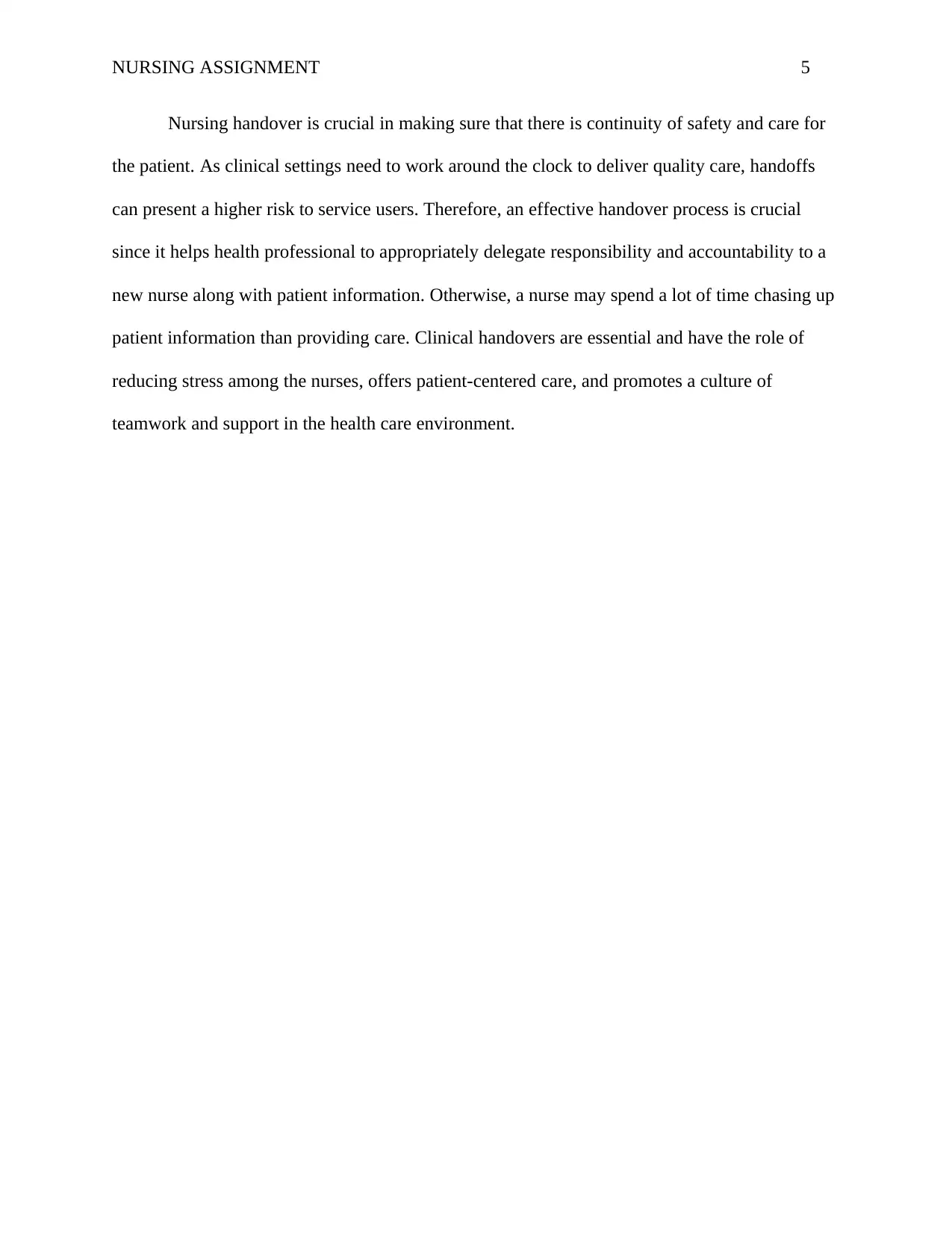
NURSING ASSIGNMENT 5
Nursing handover is crucial in making sure that there is continuity of safety and care for
the patient. As clinical settings need to work around the clock to deliver quality care, handoffs
can present a higher risk to service users. Therefore, an effective handover process is crucial
since it helps health professional to appropriately delegate responsibility and accountability to a
new nurse along with patient information. Otherwise, a nurse may spend a lot of time chasing up
patient information than providing care. Clinical handovers are essential and have the role of
reducing stress among the nurses, offers patient-centered care, and promotes a culture of
teamwork and support in the health care environment.
Nursing handover is crucial in making sure that there is continuity of safety and care for
the patient. As clinical settings need to work around the clock to deliver quality care, handoffs
can present a higher risk to service users. Therefore, an effective handover process is crucial
since it helps health professional to appropriately delegate responsibility and accountability to a
new nurse along with patient information. Otherwise, a nurse may spend a lot of time chasing up
patient information than providing care. Clinical handovers are essential and have the role of
reducing stress among the nurses, offers patient-centered care, and promotes a culture of
teamwork and support in the health care environment.
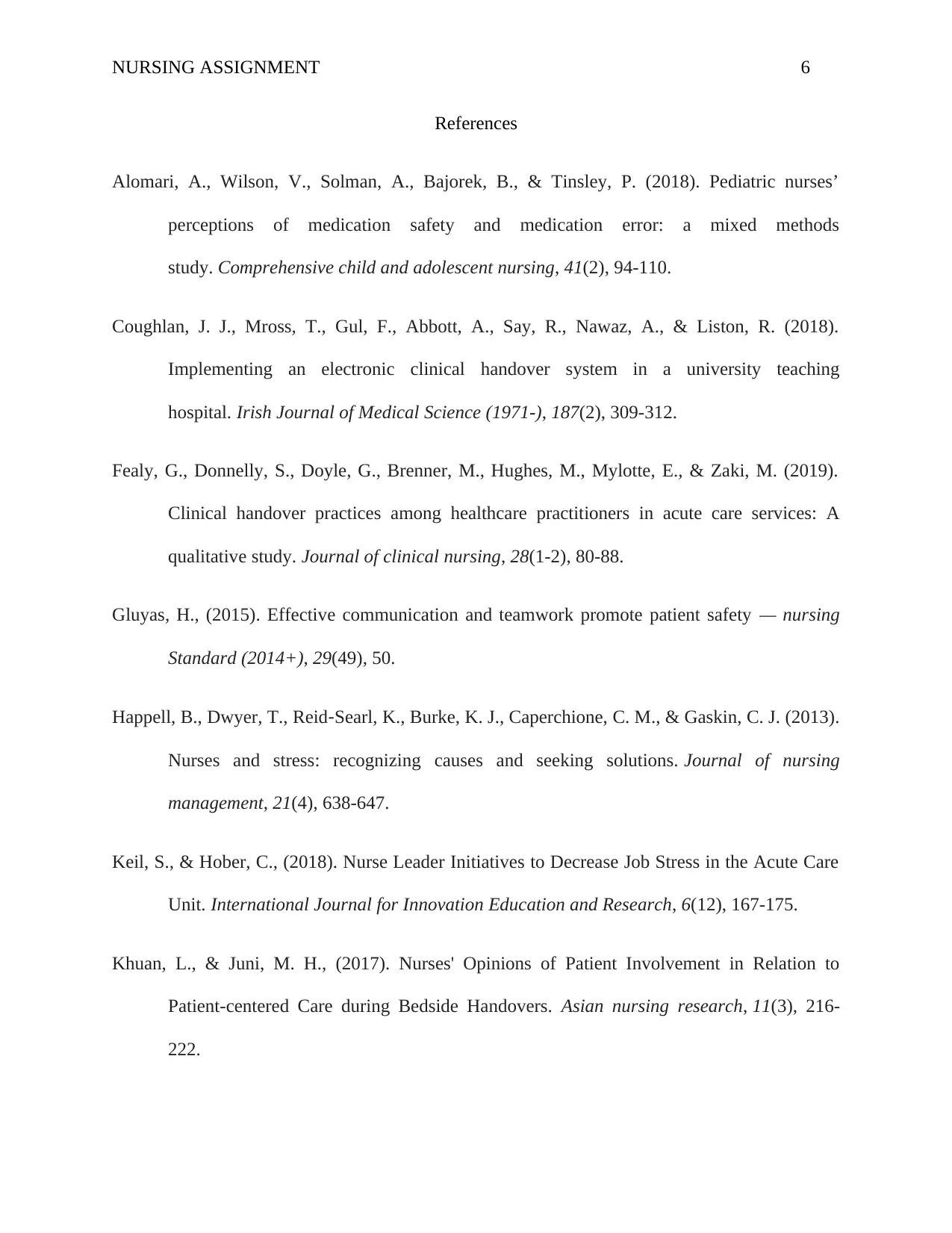
NURSING ASSIGNMENT 6
References
Alomari, A., Wilson, V., Solman, A., Bajorek, B., & Tinsley, P. (2018). Pediatric nurses’
perceptions of medication safety and medication error: a mixed methods
study. Comprehensive child and adolescent nursing, 41(2), 94-110.
Coughlan, J. J., Mross, T., Gul, F., Abbott, A., Say, R., Nawaz, A., & Liston, R. (2018).
Implementing an electronic clinical handover system in a university teaching
hospital. Irish Journal of Medical Science (1971-), 187(2), 309-312.
Fealy, G., Donnelly, S., Doyle, G., Brenner, M., Hughes, M., Mylotte, E., & Zaki, M. (2019).
Clinical handover practices among healthcare practitioners in acute care services: A
qualitative study. Journal of clinical nursing, 28(1-2), 80-88.
Gluyas, H., (2015). Effective communication and teamwork promote patient safety — nursing
Standard (2014+), 29(49), 50.
Happell, B., Dwyer, T., Reid‐Searl, K., Burke, K. J., Caperchione, C. M., & Gaskin, C. J. (2013).
Nurses and stress: recognizing causes and seeking solutions. Journal of nursing
management, 21(4), 638-647.
Keil, S., & Hober, C., (2018). Nurse Leader Initiatives to Decrease Job Stress in the Acute Care
Unit. International Journal for Innovation Education and Research, 6(12), 167-175.
Khuan, L., & Juni, M. H., (2017). Nurses' Opinions of Patient Involvement in Relation to
Patient-centered Care during Bedside Handovers. Asian nursing research, 11(3), 216-
222.
References
Alomari, A., Wilson, V., Solman, A., Bajorek, B., & Tinsley, P. (2018). Pediatric nurses’
perceptions of medication safety and medication error: a mixed methods
study. Comprehensive child and adolescent nursing, 41(2), 94-110.
Coughlan, J. J., Mross, T., Gul, F., Abbott, A., Say, R., Nawaz, A., & Liston, R. (2018).
Implementing an electronic clinical handover system in a university teaching
hospital. Irish Journal of Medical Science (1971-), 187(2), 309-312.
Fealy, G., Donnelly, S., Doyle, G., Brenner, M., Hughes, M., Mylotte, E., & Zaki, M. (2019).
Clinical handover practices among healthcare practitioners in acute care services: A
qualitative study. Journal of clinical nursing, 28(1-2), 80-88.
Gluyas, H., (2015). Effective communication and teamwork promote patient safety — nursing
Standard (2014+), 29(49), 50.
Happell, B., Dwyer, T., Reid‐Searl, K., Burke, K. J., Caperchione, C. M., & Gaskin, C. J. (2013).
Nurses and stress: recognizing causes and seeking solutions. Journal of nursing
management, 21(4), 638-647.
Keil, S., & Hober, C., (2018). Nurse Leader Initiatives to Decrease Job Stress in the Acute Care
Unit. International Journal for Innovation Education and Research, 6(12), 167-175.
Khuan, L., & Juni, M. H., (2017). Nurses' Opinions of Patient Involvement in Relation to
Patient-centered Care during Bedside Handovers. Asian nursing research, 11(3), 216-
222.
⊘ This is a preview!⊘
Do you want full access?
Subscribe today to unlock all pages.

Trusted by 1+ million students worldwide
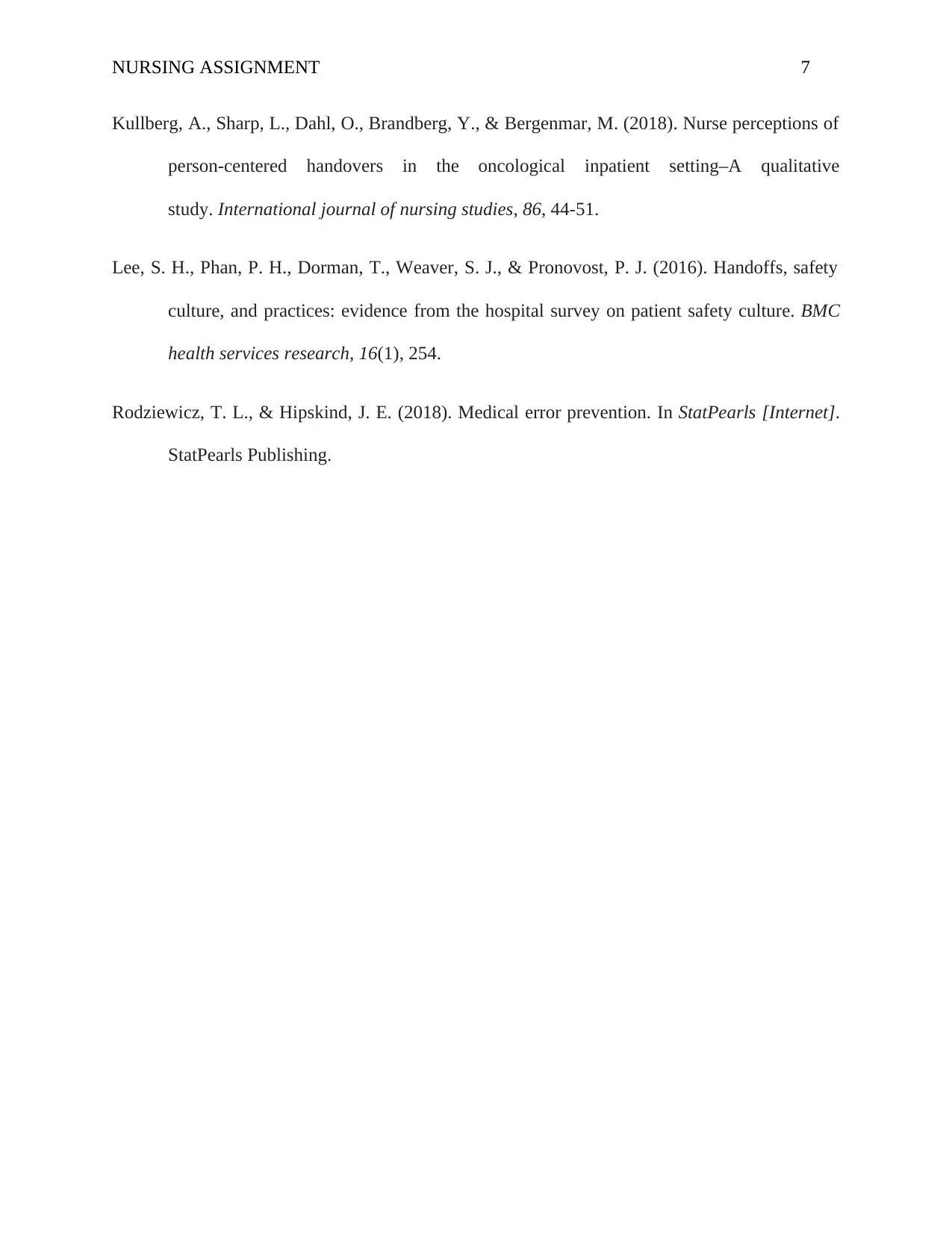
NURSING ASSIGNMENT 7
Kullberg, A., Sharp, L., Dahl, O., Brandberg, Y., & Bergenmar, M. (2018). Nurse perceptions of
person-centered handovers in the oncological inpatient setting–A qualitative
study. International journal of nursing studies, 86, 44-51.
Lee, S. H., Phan, P. H., Dorman, T., Weaver, S. J., & Pronovost, P. J. (2016). Handoffs, safety
culture, and practices: evidence from the hospital survey on patient safety culture. BMC
health services research, 16(1), 254.
Rodziewicz, T. L., & Hipskind, J. E. (2018). Medical error prevention. In StatPearls [Internet].
StatPearls Publishing.
Kullberg, A., Sharp, L., Dahl, O., Brandberg, Y., & Bergenmar, M. (2018). Nurse perceptions of
person-centered handovers in the oncological inpatient setting–A qualitative
study. International journal of nursing studies, 86, 44-51.
Lee, S. H., Phan, P. H., Dorman, T., Weaver, S. J., & Pronovost, P. J. (2016). Handoffs, safety
culture, and practices: evidence from the hospital survey on patient safety culture. BMC
health services research, 16(1), 254.
Rodziewicz, T. L., & Hipskind, J. E. (2018). Medical error prevention. In StatPearls [Internet].
StatPearls Publishing.
1 out of 7
Related Documents
Your All-in-One AI-Powered Toolkit for Academic Success.
+13062052269
info@desklib.com
Available 24*7 on WhatsApp / Email
![[object Object]](/_next/static/media/star-bottom.7253800d.svg)
Unlock your academic potential
Copyright © 2020–2025 A2Z Services. All Rights Reserved. Developed and managed by ZUCOL.





